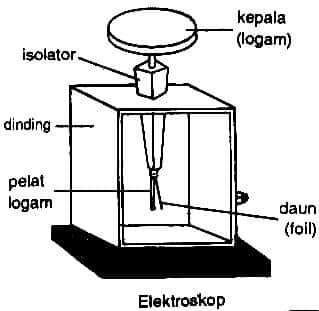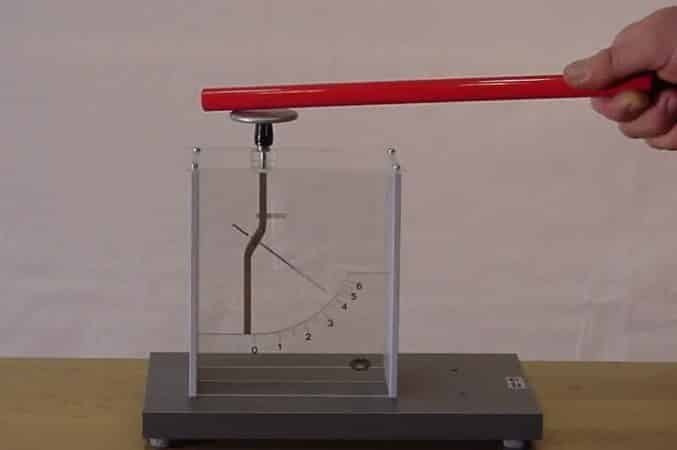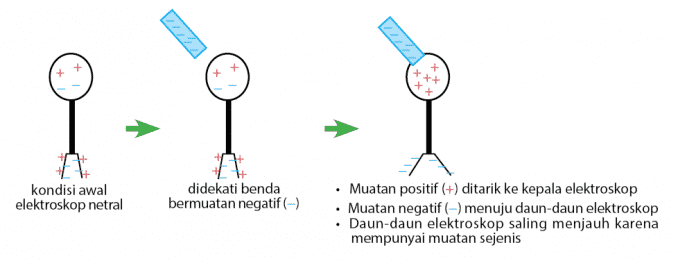Understanding Electrostop, How it Works, Making, Parts & Functions

What is Electroscope
An electroscope is an instrument used to determine the electric charge of an object. This electroscope can also be used to determine the type of charge of an object. The electroscope works on the principle of electric induction. The electroscope consists of an inside as well as an outside. On the inside, there are 2 sticks or pieces that can or can move freely and are usually made of gold. On the outside, there is a conductor separated from the rest by an insulating material. If a charged object is brought near the head of the electroscope, the gold piece will then bloom.
This electroscope is a tool used to determine the electric charge on an object. Not only that, the electroscope itself can also be used to determine the type of charge on an object. The electroscope works on the principle of electric induction.
By rubbing, an object will then acquire an electric charge. Apart from that, the electric charge can also be obtained by touching a non-charged object with a charged object.
Electrostop Function and Experiment Purpose
An electroscope is a tool that can or can be used to determine the type of charge of an object. So, the function of this electroscope is to know the type of charge of an object. However, to be able to determine the type of charge of an object is not that easy. In order to be able to determine the type of charge on an object, the charge separation must be carried out by conduction, so that the electroscope becomes charged. Furthermore, this electroscope can or can be used to determine the type of charge of an object.
The purpose of this experiment is to carry out this experiment so that you can or can make, how to work, know the concept, and can or can use an electroscope. As well as to determine the charge on the plastic ruler, when rubbed in the hair.
Electroscope Part
This electroscope consists of 2 important parts, namely the metal ball and the leaves of the electroscope. The electroscope part consists of a glass tube, 2 electroscope leaves, an insulator, and a metal ball. The leaves of the electroscope are also placed in a glass tube and are connected to a metal ball that is outside the glass tube. The link between the leaves of the electroscope and the metal ball is a conductor.
The picture below is a picture of an electroscope that is equipped with a description of the electroscope part.

Under neutral conditions, the number of positive charges on the electroscope is equal to the negative charges. The workings of an electroscope are divided into 2 ways, namely induction and conduction.
How the Electroscope Works

As explained earlier, that the workings of this electroscope are divided into two, namely induction and conduction.
Charge the Electroscope By Induction
How to charge an electroscope by induction is carried out in a neutral electroscope. The neutral electroscope, which is then approached by a negatively charged object, will attract a positive charge from the leaf to the metal ball above.
The negative charge in the metal sphere will then repel it with the charge of the object being approached and towards the leaf of the electroscope. So that the two leaves of this electroscope have excess electrons (negatively charged) and also move away from each other because they are both negatively charged.
The greater the charge, the farther the distance between the two leaves of the electroscope leg. The same condition will also occur when a positively charged object is induced in the electroscope.
How the electroscope works by induction cannot or can be used to determine the type of charge of an object. To determine the charge of an object it can or can be done by conduction.
The process of how this electroscope works can be seen in the process below.
-
Neutral electroscope is approached by a negatively charged object

-
The neutral electroscope is approached by a positively charged object

Charge the Electroscope By Conduction
How the electroscope works by conduction is done on a non-neutral electroscope. In other words, the metal sphere and the leaves of the electroscope have some kind of charge.
The charge on the metal ball is obtained by means of the process of how the electroscope works can be seen in the process below. conduction by metallic conductors.
An illustration of how the electroscope works by conduction can or can be described in a case. Suppose the initial condition of the metal ball and the electroscope has a negative or positive charge which is approached by a charged object. For more details, see the description below.
An electroscope is conducting so that it becomes negatively charged. Conditions that can or can occur when a charged object is brought near a metal ball are as follows.
- If a negatively charged object is brought close to the metal: the electrons will fall towards the legs so that the two leaves will move further away from each other
- If the positively charged object is brought close to a metal ball: these electrons will be attracted from the leaf to the metal ball so that the two leaves of the electroscope will approach each other.
- Likewise for the opposite condition.
See also the explanation of how the electrocope works in the image below to add to your understanding of the electrocope, including
1. Negatively Charged Initial Electroscope

2. Positively Charged Initial Electroscope

Electric Induction
This electric induction is an event of separation of electric charges on a neutral object, when the object is approached by an object that has an electric charge. So the electroscope leaf can expand (if the object has an electric charge) and vice versa (unchanged).
How to Make a Simple Electroscope
Tools and materials
- Used glass bottles
- Aluminum foil
- Copper wire ± 15 cm
- sandpaper
- Cork
- plastic ruler
- Paper
- Scissor
Work steps
- Take the paper
- Cut the paper into small pieces
- Put the paper in the bottle
- Take enough Aluminum.
- Cut the aluminum foil with a size of ±5 cm x 5 cm.
- Sand the copper wire and bend one end of the copper wire until it is shaped like a semicircle or like the letter U.
- Place a piece of Aluminum foil at the end of the copper wire that has been or has been bent and then fold the Aluminum foil.
- Insert the copper wire that has been or has been given Aluminum foil into the bottle
- Cover the bottle with a cork
- Make the aluminum foil into a ball and stick it to the copper end on the outside of the bottle.
- Rub a plastic ruler in your hair and hold it close to the aluminum foil that has been or has been shaped like a ball earlier, and observe what happens, is the aluminum foil in the bottle still/moving to open (bloom) and also how the paper in the bottle is, still/moving.
That's an explanation of the Definition of an Electrostop, How it Works, Making, Parts & Functions, hopefully what is described can be useful for you. thank you
See AlsoUnderstanding the Capital Market, Benefits, Types, and Instruments
See AlsoUnderstanding Asset Management, Goals, Cycles & According to Experts
See AlsoUnderstanding Paradigm
